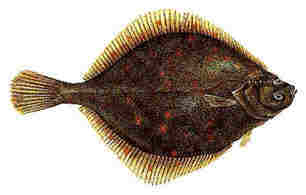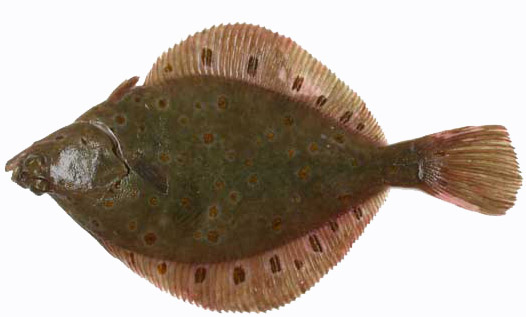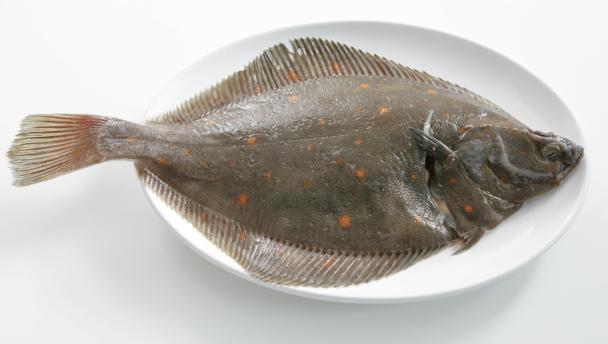
Pleuronectes platessa
FAMILY
Pleuronectidae
TAXONOMY
Pleuronectes platessa Linnaeus, 1758, European seas.
OTHER COMMON NAMES
English: European plaice; French: Plie d’Europe, carrelet; German:
Scholle; Spanish: Solla europea.
PHYSICAL CHARACTERISTICS
Dextral flatfish with a deep, oval body; a relatively large head;
large eyes; a small mouth; and a series of four to seven bony
knobs on the head along a curved line from the eyes back to
the lateral line. Teeth are best developed on the jaws of the
blind side. Strong, molariform pharyngeal teeth are present on
the gill arches. Lateral line is curved slightly above the pectoral
fin. Scales are cycloid on both sides of the body. Distinctive
ocular side coloration, consisting of a uniformly brown background
with brilliant red or orange spots. Blind side usually is
uniformly white. The species can reach lengths to about 39.4
in (100 cm) and weights up to 7.9 lb (3.6 kg), but most adults
average only about 13.8–19.7 in (35–50 cm) and weights of
about 2.2 lb (1 kg). Individuals can reach at least 30 years of
age, but most are much younger. Females grow faster and live
longer than males, which rarely live longer than 10–12 years.
DISTRIBUTION
Northeastern Atlantic Ocean in marine and sometimes estuarine
waters from the White and Barents Seas southward to the
North Sea, including the British Isles and western Baltic Sea;
off Iceland; occasionally off Greenland; and along the European
coast from Germany and Denmark south to Spain and
Portugal and in the western Mediterranean Sea.
HABITAT
Usually found on the inner continental shelf from shallow waters
to about 656 ft (200 m) but most abundant in 33–164 ft
(10–50 m); usually occur in waters of 35.6–59°F (2–15°C).
Most commonly found on sandy sediments but also occur on
mud or gravel bottoms. Newly settled plaice recruit to inshore
waters typically between 9.8 and 88.6 ft (3–27 m), and sometimes
juveniles are found in sandy intertidal pools. Plaice can
tolerate reduced salinity levels but do not usually penetrate estuaries
to any great degree and are not typically found in freshwater
reaches within estuaries. During their first year, young
plaice generally are found in shallow waters. By their second
year, they begin to move to deeper waters. Older and larger
plaice tend to live deeper than smaller and younger plaice.
BEHAVIOR
A diurnally active, benthic fish that lies partially buried when
possible. Plaice remain stationary for long periods of time, lying
partially buried in the sediment. They are often active at
night, especially in shallow water, and have been reported to
exhibit homing
BEHAVIOR
, at least in near-shore environments.
Where there are tidal currents, the plaice orientates itself by
pointing into the current and retains its position by pressing its
dorsal and anal fins against the bottom. Many individuals congregate
in the same general area. Plaice, including larger individuals,
sometimes move on rising tides into intertidal areas to
forage, retreating with the receding tide.
FEEDING ECOLOGY AND DIET
Opportunistic, visual predators that feed mainly during daylight
hours. After metamorphosis, juvenile plaice consume small
polychaete worms and harpacticoid copepods, but with increasing
size their diet broadens to include a wider variety of prey,
such as small crustaceans, amphipods, cumaceans, and small
mollusks. Larger plaice consume a greater proportion of thinshelled
bivalve mollusks, especially the siphons of burrowing
species (which they nip off using the teeth of their blind-side
jaws), as well as gastropod mollusks, shrimps, small crabs, and
various polychaete worms. Feeding activity varies with season
(temperature), with higher feeding rates occurring during
warmer periods than during wintertime. The plaice takes its
food in a nearly horizontal position, with its head raised slightly
off the bottom. Predators that consume plaice include sculpins,
lumpfish, spiny dogfish, weaver fish, seals, and cormorants.
Shrimps and ctenophores prey on plaice in the early-life stages.
REPRODUCTIVE BIOLOGY
Maturity schedules vary, depending upon the area where the
fish live, their food supply, and ambient temperatures. Female
plaice reach sexual maturity between three and seven years of
age (11.8–15.7 in, or 30–40 cm) and males at two to six years of
age (7.9–11.8 in, or 20–30 cm) in the North Sea. Plaice spawn
throughout their range, usually on well-defined spawning
grounds. The spawning season varies with latitude and location
but usually occurs in the early months of the year throughout
its range (December to March in the North Sea, February to
March off Denmark, and March to April off Iceland), when water
temperatures are about 42.8°F (6°C). Mature fish may undertake
extensive migrations from feeding grounds to discrete
spawning grounds. The extent of migration depends upon the
individual stocks. Spawning grounds generally are located at
depths of 66–131 ft (20–40 m). Males and females may pair up
and swim one above the other during spawning. Plaice do not
guard a nest but rather scatter eggs, which may number up to
50,000 during a spawning event. Eggs are planktonic at first,
gradually sinking as development proceeds. Hatching occurs in
18–21 days, depending on temperature. The larval stage lasts
between four and six weeks, after which the fish metamorphose
at about 0.4–0.7 in (10–17 mm) in length.
CONSERVATION STATUS
Not threatened, although stock sizes have declined over time
as a result of overfishing, habitats destruction, and pollution.
SIGNIFICANCE TO HUMANS
One of the most familiar flatfishes in northern European waters,
highly desired owing to its size, abundance, and edible
qualities. It is the single most important commercial flatfish to
the fisheries of Europe. The species also is targeted by a large
recreational fishery. Plaice are considered a potential species
for aquaculture and are kept as an aquarium species.
Other popular Animals
Photo Gallery of - Plaice





 Animalia Life
Animalia Life